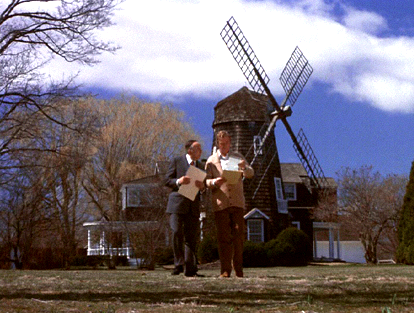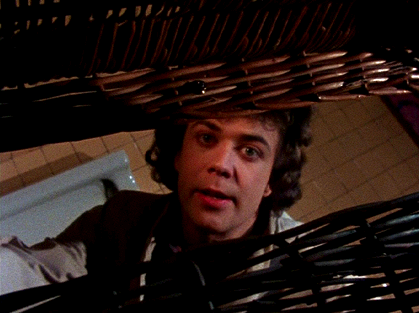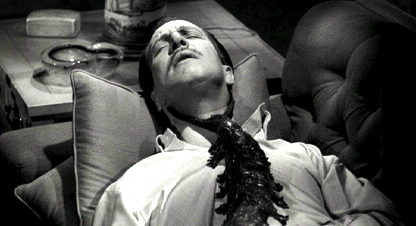Director: Terry Zwigoff
Writers: Daniel Clowes, Terry Zwigoff (adapting Daniel Clowes’ Ghost World comic book stories)
Producers: Liane Halfon, John Malkovich, Russell Smith
Cast: Thora Birch, Scarlett Johansson, Steve Buscemi, Brad Renfro, Bob Balaban, Illeana Douglas, Stacey Travis, Dave Sheridan, Brian George, Ezra Buzzington, Tom McGowan, Pat Healy, Debra Azar, T.J.Thyne, Rini Bell, Dylan Jones, Ashley Peldon, David Cross, Bruce Glover, Teri Garr (uncredited)
Best friends Enid (Thora Birch) and Rebecca (Scarlett Johansson) are two contrarian girls that have just graduated high school. As they are both coming to grips with starting adulthood, Enid befriends a much older, eccentric, music buff named Seymour (Steve Buscemi). Enid’s growing relationship with Seymour strains her friendship with Rebecca.
The Flashback Fanatic movie review
As soon as I heard that Daniel Clowes’ work would be adapted to film, I knew I had to see it. I was absolutely delighted with the result. Frankly, I remembered very little of the Ghost World comic book stories, so the film made a pretty fresh impression on me. This may come as faint praise from this retro reprobate that disdains much of contemporary popular culture, but heed me when I proclaim that Ghost World is the best film of the twenty-first century! Okay, so I admit it’s also one of the few films that I have seen made in this century. However, that praise IS coming from the man that can discern the merits of neglected masterpieces such as Frankenstein Meets the Space Monster (1965) and Cauldron of Blood (1967), so I must know what the hell I am talking about.
Since director Terry Zwigoff had made the acclaimed documentary Crumb (1994) about the famous underground comix artist Robert Crumb, adapting the stories of another out-of-the-mainstream cartoonist seems like a natural progression. Clowes and Zwigoff are a match made in pop culture purgatory. They seem to share a quirky, sardonic, and morose simpatico that makes the Ghost World film so unique.
This dramedy is a coming of age story that does not give us character arcs resulting in triumphant resolutions. It is not teen-centric pandering stroking a youthful audience into believing they have all the answers and that their cynical affectations make them strong. Ghost World deals with that uncertain limbo between adolescence and adulthood.
The reason that we care about teenagers Enid and Rebecca is that they are interesting personalities. They reject the shallowness and conformity of most of their peers while they are both fascinated and amused by the oddballs in their world. They strive for individualism that will suit them, even as they are frustrated with a world that will impose responsibility upon them.
Thora Birch is just wonderful as Enid. She is perceptive, sensitive, impulsive, and funny. She may be rude at times, but she is also introspective and confused. We can’t help but empathize with her as she suffers the presence of her ineffectual father (Bob Balaban) and all the louts that she encounters.
Scarlett Johansson, as Enid’s best friend Rebecca, is the terse and stoic counterpoint to Enid’s whimsy and volatility. When Enid refers to herself as cute in an old childhood photo, Rebecca’s response absolutely slays me. Rebecca does share a lot of Enid’s contrarian attitudes, but she seems to be more pragmatic about accepting that the “real world” will demand decisions and responsibilities.
All around these two funny and frustrated girls are the many strange characters that conform to the silly and dehumanizing world around them. However, conformity does not keep people from becoming puzzling weirdos or grotesque louts. Ghost World is loaded with hilarious performances in roles large and small.
The one oddball that becomes the most sympathetic character in the movie is Seymour (Steve Buscemi). He is an office worker and loner that obsesses about his old-time blues and jazz record collection and has general contempt for most of contemporary society. He is the victim of an anonymous prank Enid perpetrates. Once Enid meets Seymour, she finds a kindred spirit in the middle-aged man’s eccentricity and nonconformity.
Melancholy looms over all of the humor in this story. We fear that the demands of dreary adulthood in a shallow culture will destroy the nonconformist idealism of Enid and Rebecca. Now that’s a horror that this fright flick junkie just can’t handle.



























































